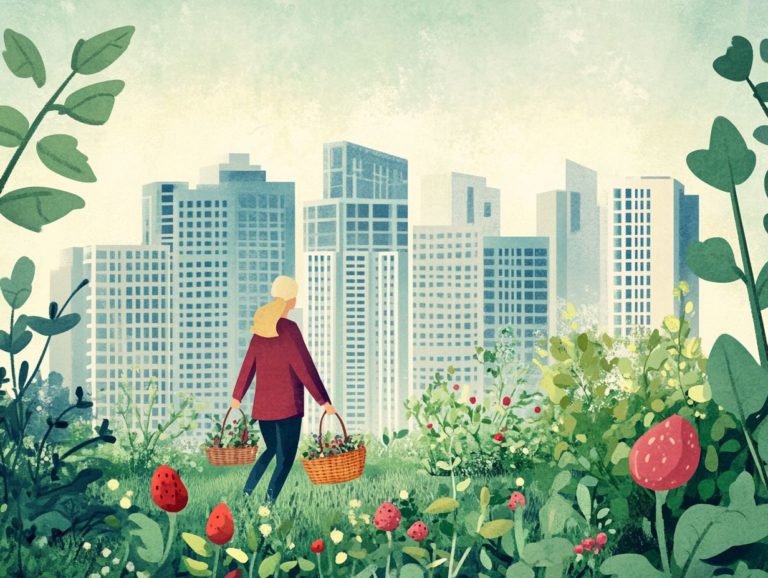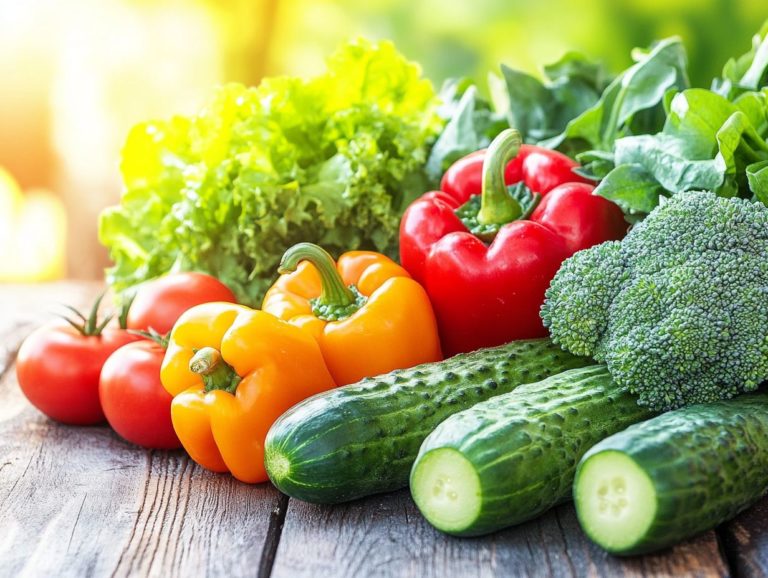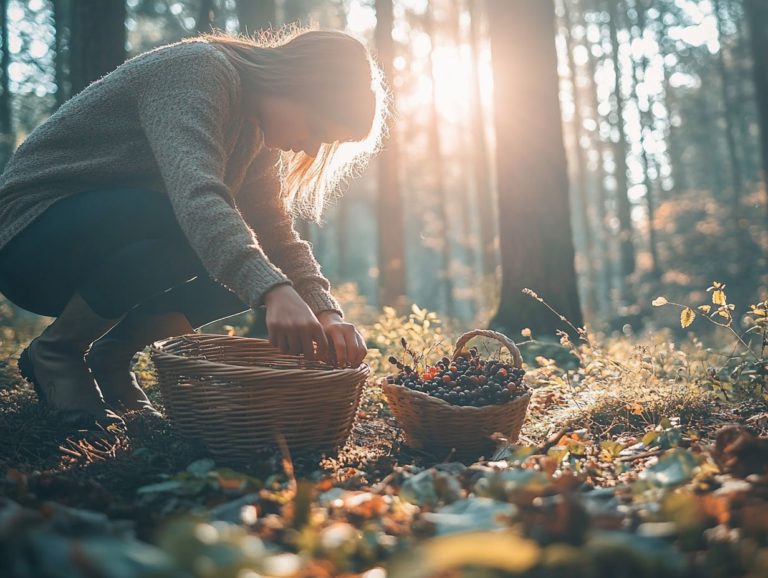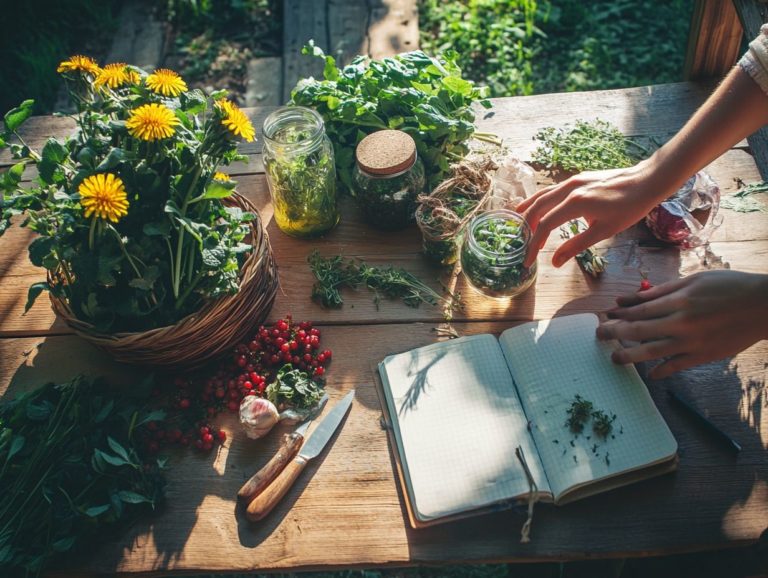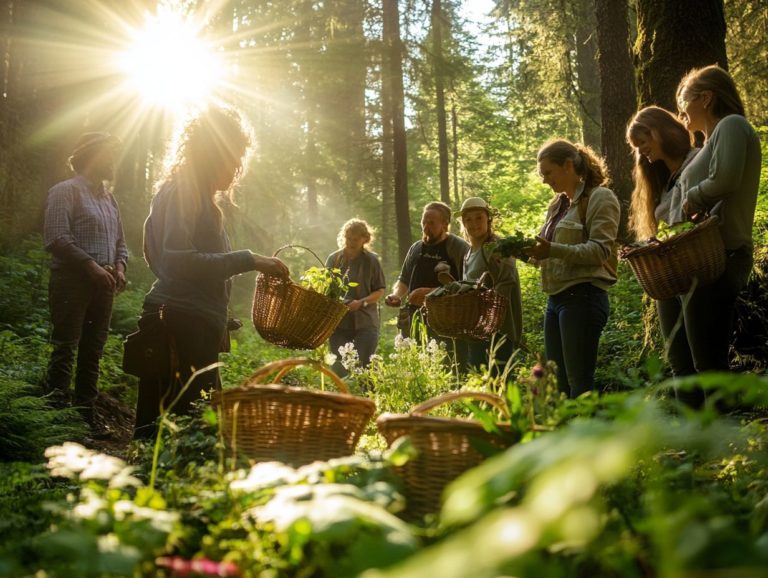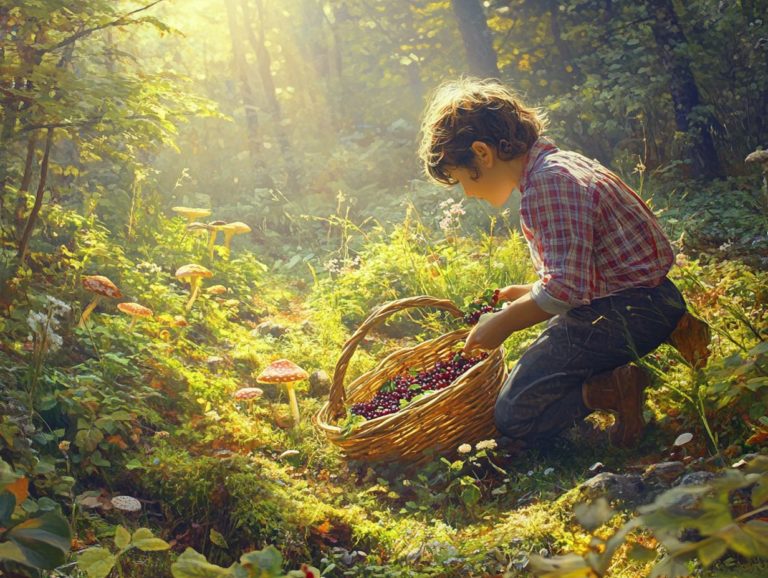What are the Best Foraging Books?
Imagine stepping into your backyard and uncovering nature s hidden gems! Foraging is a time-honored practice that reconnects you with the land, allowing you to discover the hidden treasures of edible plants and fungi right in your own backyard. By exploring gathering wild food, you can find local treasures that enhance your wild food adventures.
To embark on this journey, a reliable foraging book can serve as your best guidebook, providing valuable insights into identifying safe and delicious wild foods.
This article delves into the benefits of foraging books, highlights what to consider when choosing one, offers top recommendations like Sam Thayer’s books, and shares essential foraging safety tips to ensure your adventures are both safe and rewarding.
Dive in and uncover the joys of foraging!
Contents
Key Takeaways:
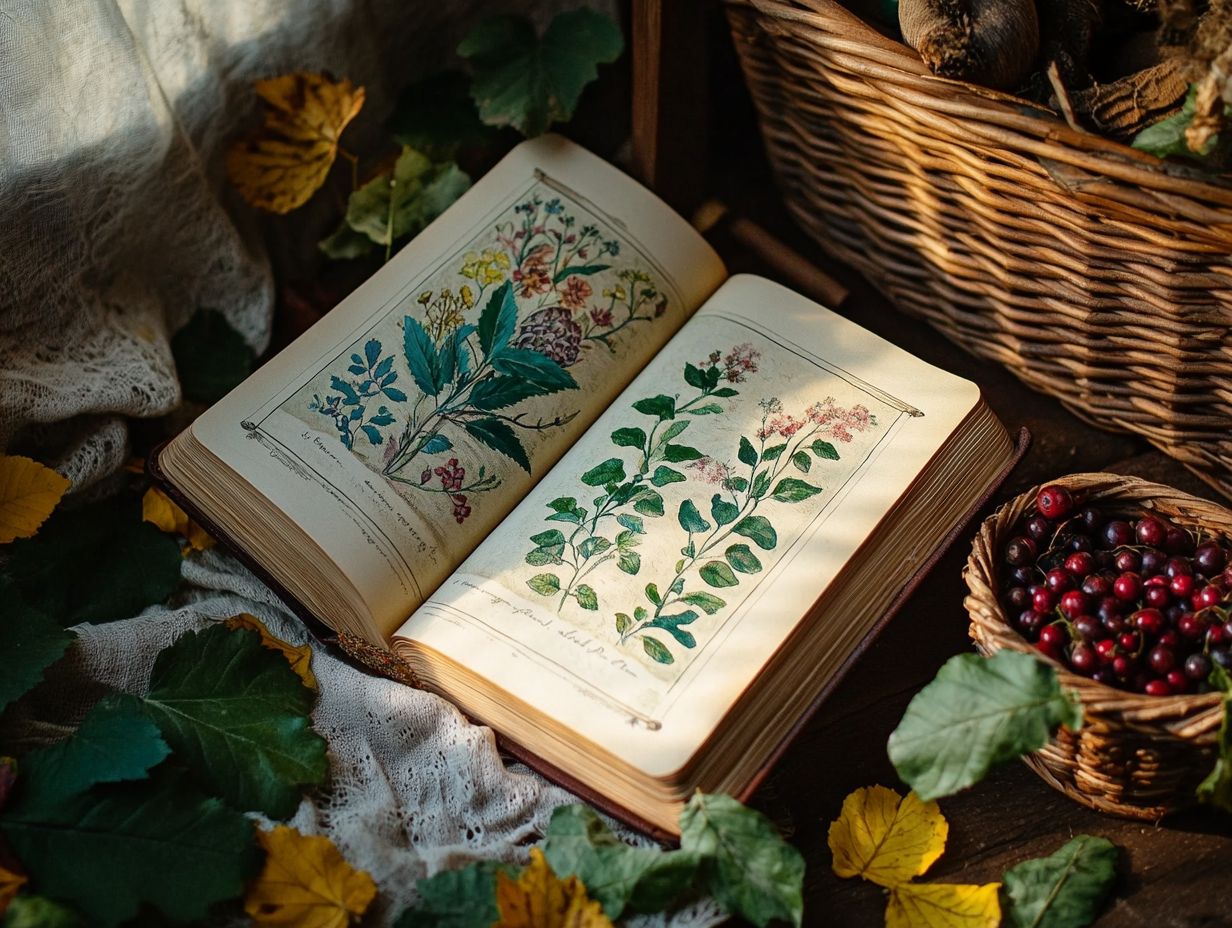
- Expand your knowledge of wild foods with foraging books!
- Consider the author’s credibility and the book’s format and content when selecting your guide.
- Check out top recommended foraging books to learn how to safely and successfully gather wild foods!
What is Gathering Wild Food?
Gathering wild food is the art of searching for and collecting wild food resources, including edible plants and mushrooms that nature has to offer.
This practice has its roots in a time when survival hinged on the ability to locate wild edibles. Today, it has transformed into a contemporary trend celebrated for its deep connection to local ecosystems and culture.
With a rising focus on sustainability, gathering wild food has regained its significance, reminding us of the age-old relationship between humans and the environment.
Different types of gathering, such as wildcrafting (the collection of plants for medicinal purposes), go beyond just food to encompass medicinal plants. This underscores the importance of ethical practices that honor nature and biodiversity.
Foraging plays a significant role in the modern culinary scene as chefs incorporate foraged ingredients to elevate flavors and craft distinctive dishes. This showcases that the ancient wisdom of foraging remains relevant and essential in today s food landscape.
Benefits of Foraging Books
Foraging books are critical treasures for anyone eager to embrace the art of gathering wild foods. They offer a trove of knowledge and can point you to the best resources for local foraging, elevating a simple outdoor stroll into a rewarding adventure.
Within their pages, you’ll find insights on identifying edible plants, understanding their nutritional benefits, and exploring their culinary and medicinal uses. They also highlight the significance of ethical foraging practices.
With guidebooks penned by experts like Sam Thayer and Ellen Zachos, you gain access to trustworthy information on local edible plants and seasonal gathering techniques. Their books seamlessly incorporate foraged ingredients into delectable recipes.
Learning about Edible Plants and Fungi
Learning about edible plants and fungi is essential for your gathering journey. It not only gives you the power to identify safe and nutritious wild food options but also deepens your connection with nature.
Understanding the characteristics of various edible plants from familiar weeds like dandelions to intriguing wild mushrooms enhances your culinary experiences. This knowledge allows you to experiment with diverse wild food recipes that celebrate the flavors of the great outdoors.
By mastering seasonal plant identification, you can maximize your harvest throughout the year, perfectly aligning with nature’s rhythms. Recognizing edible species goes beyond safety; it transforms your meals into an exciting adventure.
These ingredients often come with impressive nutritional profiles, packed with vitamins, minerals, and antioxidants. Familiarizing yourself with key identifying features such as leaf shape, color, and growth patterns helps you avoid potentially harmful lookalikes.
Seasonal changes play a significant role in the availability of these culinary treasures. Springtime is particularly bountiful for wild greens, while autumn is a treasure trove for mushroom enthusiasts on the hunt for varieties like chanterelles or porcini.
Embracing this adventure can lead to delightful discoveries and a profound appreciation for the world around you.
So grab a guidebook and start exploring today!
Connecting with Nature
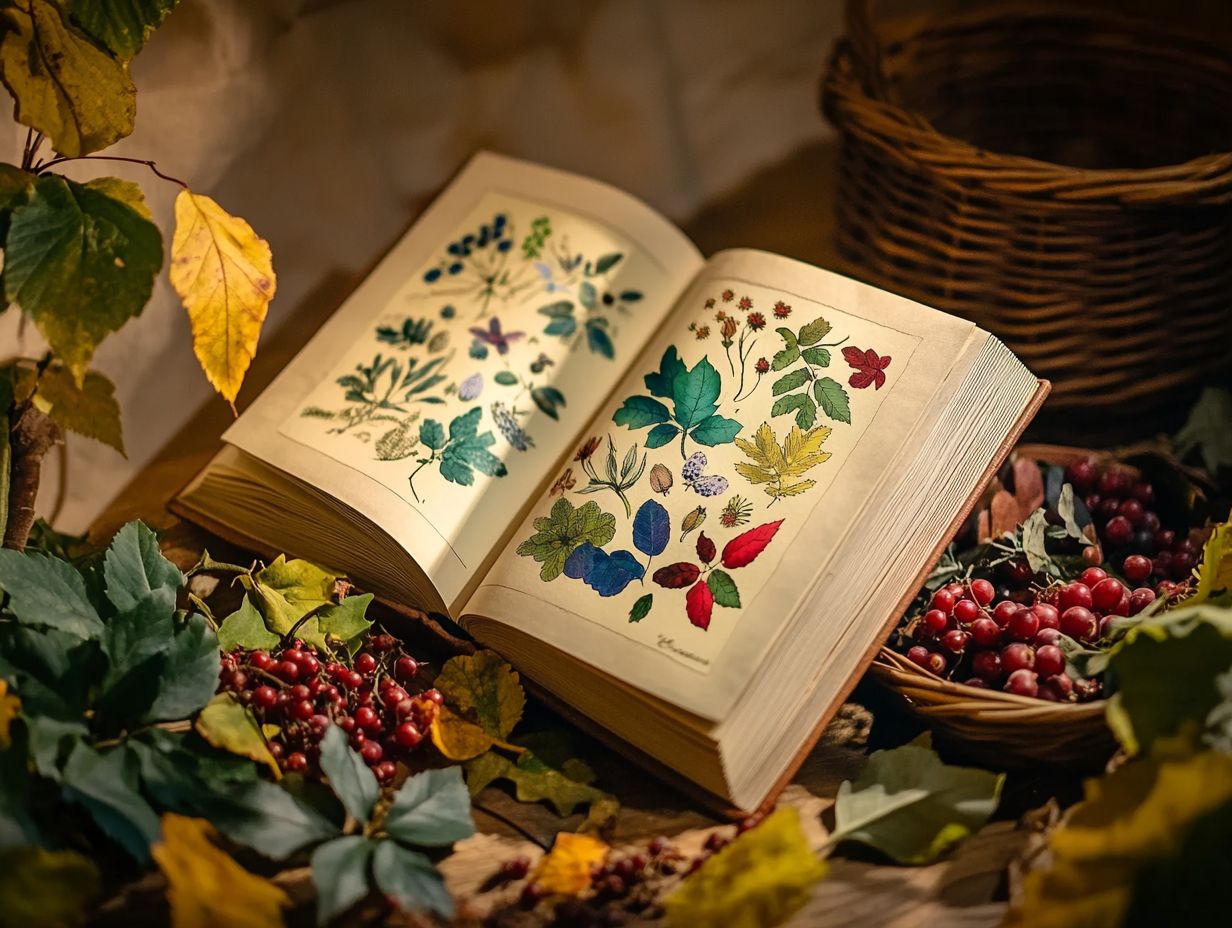
Foraging connects you with nature and allows meaningful interaction with the environment. You ll explore local ecosystems and learn about edible and medicinal plants.
Sustainable foraging practices let you gather wild ingredients responsibly. This nurtures a sense of stewardship toward nature, meaning caring for nature and protecting it for future generations.
This journey cultivates mindfulness, allowing you to immerse yourself fully in the present moment as you gather nature’s gifts. As you identify different species and their uses, you ll become increasingly aware of the essential roles these plants play in the ecosystem, enhancing your appreciation for environmental conservation.
Imagine the thrill of discovering fresh wild ingredients! It can inspire your culinary creativity and lead to healthier eating habits, transforming every meal into a delightful adventure. Exploring local areas for foraging opportunities can lead to enchanting surprises and foster a genuine respect for the abundance that surrounds you.
Factors to Consider When Choosing a Foraging Book
When selecting the ideal foraging book, several key factors can profoundly influence your foraging journey and success. First, consider the author’s experience and credibility. Books penned by established authorities in foraging, like Sam Thayer and Wildman Steve Brill, typically offer the most accurate and trustworthy information.
Pay attention to the book’s format whether it features photographs, illustrations, or straightforward foraging techniques because these elements can significantly enrich your learning experience and bolster your confidence in identifying wild plants and mushrooms.
Author’s Experience and Credibility
The experience and credibility of an author are crucial in determining the quality of a foraging book. Authors like Sam Thayer and Wildman Steve Brill are renowned for their extensive, hands-on foraging experience, giving a trustworthy voice to their writing.
Their backgrounds enrich the content, ensuring you receive practical insights drawn from real-world experience in foraging various edible plants and mushrooms, enhancing both your safety and enjoyment.
With a profound understanding of botany and ecology, these authors have honed their skills over many years and made significant contributions to the foraging community. They offer workshops, lead foraging tours, and engage in educational outreach, providing invaluable guidance on how to identify and responsibly harvest wild edibles.
Relying on credible sources is very important; inaccurate information can lead to potentially harmful mistakes. By studying reputable foragers, you can confidently navigate the wild, ensuring that your discoveries are both safe and nourishing.
Book Format and Content
The format and content structure of a foraging book are key elements that significantly influence its usability and effectiveness as your guide for gathering wild foods. A well-organized book should ideally include clear sections on plant foraging techniques, seasonal plant identification, and important safety tips. High-quality photographs or illustrations often complement this information, helping you identify both edible and medicinal plants with ease. This thoughtful design ensures you can quickly reference vital details while out foraging, making your experience safer and far more enjoyable.
As you explore various formats, you might come across hardcover guides that offer durability and a wealth of information, perfect for dedicated foragers. Ebooks might catch your eye as well; they provide portability and instant access, making them ideal for those constantly on the move, even if they sometimes lack the visual appeal of printed images. Pocket-sized field guides are incredibly convenient, offering essential information in a compact format, though they may sacrifice a bit of detail.
No matter which format you choose, the integration of vivid illustrations and photographs is crucial for aiding identification, as it gives you the power to make confident choices. When selecting a book, consider your specific interests whether they’re medicinal uses, culinary applications, or general edible wild plants to truly enrich your foraging journey.
Top Recommended Foraging Books
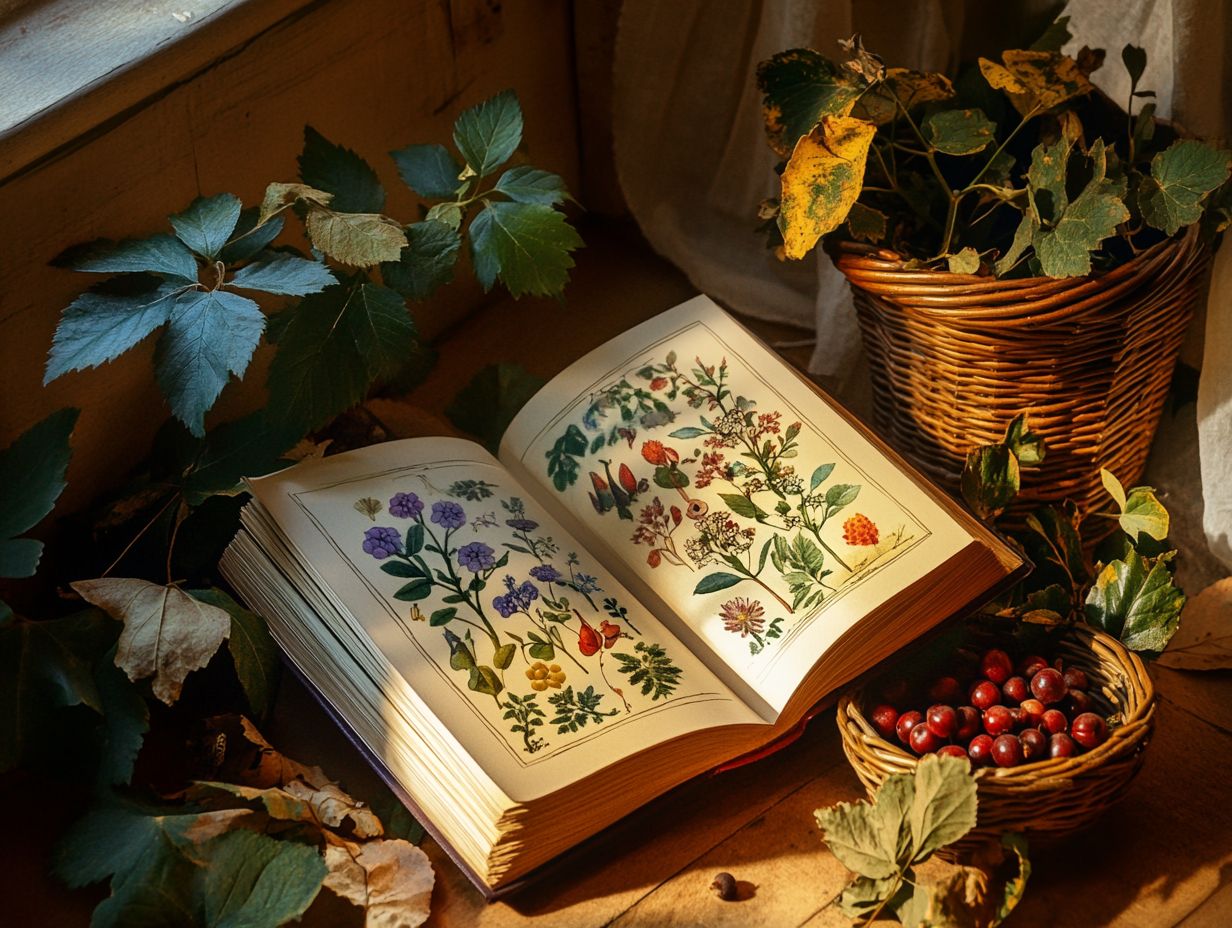
In the realm of foraging literature, a select few books emerge as critical resources for both novice and seasoned foragers.
Consider diving into the works of Sam Thayer, renowned for his thorough exploration of wild plants. His titles, alongside comprehensive wild food recipe books, are considered some of the finest foraging guides available today.
These essential reads not only equip you with practical knowledge for identifying edible plants and fungi but also ignite your culinary creativity with unique recipes that celebrate the rich flavors of the natural world.
Reviews and Descriptions of Each Book
Providing reviews and descriptions of popular foraging books can significantly aid you in making informed decisions about which guides to invest in for your foraging journey. Each book offers unique insights into wild food recipes, plant identification resources, and foraging techniques, catering to various skill levels and interests.
Whether you re looking for detailed descriptions of local edible plants or practical guides on ethical foraging practices, the right book can genuinely enhance your knowledge and boost your confidence in foraging.
You might gravitate toward a book that features vivid photographs for easier identification or perhaps one that includes comprehensive maps pinpointing places rich in edible plants. Some guides excel in offering a user-friendly layout, making it simple for you to navigate through sections like seasonal foraging tips or recipes.
On the flip side, a few books may disappoint with outdated information or lack in-depth coverage of certain regions.
Think about what you want from your foraging book. Are you after a quick reference guide or a more scholarly exploration? This reflection ensures that your choice aligns perfectly with your foraging aspirations.
Tips for Using Foraging Books
Make the most of your foraging adventure by embracing key safety tips that elevate both your reading and foraging experiences.
Prioritizing key safety guidelines is essential; you must clearly understand the crucial distinctions between edible and toxic plants.
Use the plant foraging techniques outlined in these guides to gather responsibly, respecting nature while promoting sustainability.
Best Practices for Safe and Successful Foraging
Safe and successful foraging is crucial for a rewarding outdoor experience. Always remember: never consume unknown plants!
Learn to identify edible varieties in your area and understand the environmental and legal regulations involved.
By using effective foraging methods and sustainable practices, you deepen your knowledge and respect for the ecosystem.
Engaging with local communities offers valuable insights into the best foraging spots and seasons while fostering camaraderie among fellow nature lovers.
Educate yourself on the characteristics of edible plants and the legal implications of gathering in protected areas.
Practice responsible harvesting methods. Take only what you need and never overexploit resources.
Connecting with seasoned foragers greatly enhances your understanding and appreciation of wild food sources.
Frequently Asked Questions
What are the Best Foraging Books?
There are so many great foraging books out there, it can be overwhelming to choose just one. Here are some recommended options:
What makes a foraging book one of the best?
A good foraging book should provide accurate information and identification of wild mushrooms and fungi, as well as tips for sustainable wildcrafting and safe foraging practices.
Are there foraging books specifically for beginners?
Yes, there are several foraging books designed for beginners, such as “The Forager’s Harvest” by Sam Thayer and “Foraging: A Beginner’s Guide to Wild Edible and Medicinal Plants” by Karen Stephenson, along with resources like Backyard Foraging by Marie Viljoen.
Can I find foraging books for specific regions?
Absolutely! Many foraging books focus on specific regions or climates, such as “Pacific Northwest Foraging” by Douglas Deur, “Foraging New England” by Tom Seymour, or Natures Garden Guide for broader insights.
Are there foraging books that cover both plants and fungi?
Yes! There are several foraging books that cover both plants and fungi, such as “Edible Wild Plants: Eastern/Central North America” by Lee Allen Peterson, “Mushrooms Demystified” by David Arora, and herbalism books that delve into the medicinal uses of wild herbs.
Are there any foraging books that also include recipes?
Yes! There are several foraging books that include recipes for cooking with wild edibles, such as “The Forager’s Kitchen” by Fiona Bird and “The Wildcrafting Brewer” by Pascal Baudar, in addition to other wild food recipe books that highlight culinary wild foods.
Ready to start your foraging adventure? Join local foraging groups and connect with like-minded enthusiasts today!


